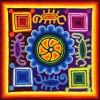The following is a quote from the first chapter of the excellent book by Hurlburt and Heavey on this topic published in 2006. Although the book is intended for academic researchers (the small 260 page book costs over $120 USD), it is quite accessible, easy to read, and recommended for those interested in this technique. At Hurlburt's website, linked below, there are PDFs of several of the papers he's authored on the subject and are more than enough for a solid understanding of the technique and its applications.
From Chapter 1 of Exploring Inner Experience by Hurlburt and Heavey:
The exploration of inner experience has fallen into disrepute, and this book is intended to contribute to its restoration. By "inner experience" we mean anything that is going on in your awareness at any particular moment. Athought, feeling, tickle, sensation, kinesthetic awareness, image, perceptual awareness, whatever is "before the footlights of consciousness" as WilliamJames said. We'd like to throw the net as widely as possible at the concept of inner experience. Your inner experience is whatever is in your awareness at any particular moment.
Some observers have preferred the terms "consciousness," "conscious experience," "experience," or "in awareness" to the term "inner experience," because "inner experience" seems to favor "inner" experiences such as thoughts and feelings over "outer" experiences such as visual perception and sensation. We believethat there is no best term; all have their advantages and drawbacks. Suffice it to say that by "inner experience" we mean anything that emerges, or coalesces, or becomes a phenomenon, or is experienced, out of the welter of inner and outer stimuli that simultaneously impinge on a person. That definition may seem loose or vague, but it turns out, as we shall seein the next section, that the definition can be quite unambiguous in practice.
Descriptive experience sampling
We have been exploring inner experience since the early 1970s using a method we call Descriptive Experience Sampling (DES). DES givespeople a beeper that emits a beep through an earphone at random times. If you're a DES subject, you wear this beeper in your own natural environments, as you engage in your everyday activities - at work, at home, driving between the two, playing tennis, writing a paper, cooking dinner, reading, and so on. Your task is simply to pay attention to whatever you were experiencing at the moment you hear the beep, and to jot down in a notebook the characteristics of that experience. If you were thinking, we want to know the details of the thought. If you were feeling some emotion, we want to know how that felt; if you were visually focused on the external environment, we want to know what you were seeing; if you were seeing an inner image, we want to know about that experience; if you were hearing some external event, we want to know what it sounded like; and so on. As you may have noticed, the DES method follows directly from the definition of inner experience: DES tries to describe whatever is in your awareness at any particular moment. We use the beeper to define the particular moment, and simply ask you to report what's in your awareness at that moment.
The overwhelming majority of people who have engaged in this kind of study do find it easy to pay attention to what's going on at the beep, despite the fact that prior to sampling, they don't think they can do it. Prospective DES subjects often try, as informal preparation for their sampling participation, to pay attention to their inner experience and find that paying attention to be very difficult. But during sampling, most find that paying attention to their awareness at the moment of the beep turns out to be an easy thing to do. The turnaround is striking: most subjects go from believing they can't do it at all to finding that it's easy.
The beeping process itself is easy. It's the simulation of the beeping process that is difficult. In the simulation, prospective subjects must pretend they are being beeped, which is something like asking, "What's going on in my inner experience right now?" What's actually going on in experience right then is the question itself, "What's going on?" However, that question is ruled out, and it therefore seems that there isn't anything apprehendable in awareness at that particular moment, and therefore that the attempt to apprehend inner experience is difficult or impossible. That's a mistake - a mistake shared by many influential philosophers, but a mistake nonetheless.
It turns out that, for most people, actually wearing the beeper makes it easy to "catch awareness in flight." Once subjects get the hang of it, the beep frees them from having to ask what's going on; with a little practice, they easily develop the skill of letting the beep cause them simply to pay attention to whatever happens to be ongoing in awareness.
This book shows that DES is an effective way of exploring inner experience, and that the descriptions it provides are largely accurate characterizations of ongoing inner experience.


